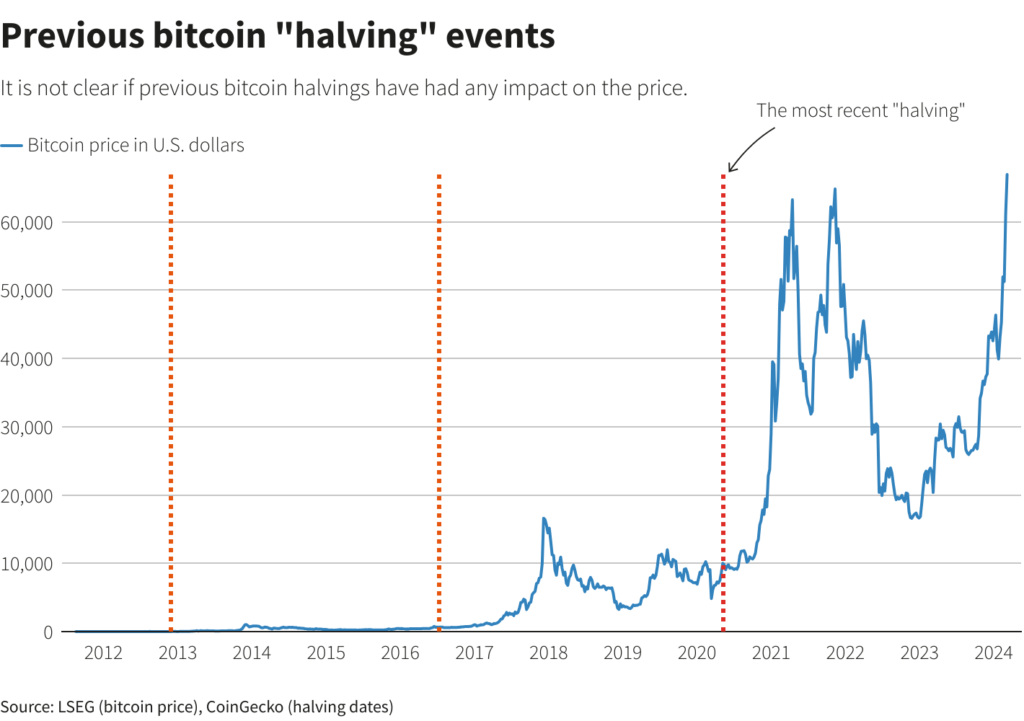-
The recent Bitcoin halving has sparked discussions about its impact on the cryptocurrency’s supply dynamics and price stability.
-
Regulatory attitudes towards Bitcoin have evolved over time, with regulatory authorities increasingly accepting and appraising Bitcoin-linked trading products such as ETFs.
-
Miners’ post-halving adjustments in mining strategies may affect network security and transaction processing times.
The world’s largest cryptocurrency recently completed its “halving,” a significant event occurring roughly every four years. CoinGecko, a leading cryptocurrency data and analysis company, confirmed this occurrence. Following the halving, Bitcoin experienced relatively stable trading, with a marginal decrease of 0.47% to $63,747.
Bitcoin Halving: What It Means for Digital Currency
The Bitcoin halving, a highly anticipated event, signifies a pivotal change in the cryptocurrency’s underlying technology. This change, designed to reduce the rate at which new bitcoins are created, is a feature embedded in Bitcoin’s code by its pseudonymous creator, Satoshi Nakamoto.
Halving the rewards that cryptocurrency miners receive for creating new tokens effectively makes it more costly to introduce new bitcoins into circulation. This change sparks curiosity and anticipation among cryptocurrency enthusiasts.
For many cryptocurrency enthusiasts, the halving underscores Bitcoin’s value as an increasingly scarce commodity. With Nakamoto capping the Bitcoin supply at 21 million tokens, some view the halving as a mechanism to enhance Bitcoin’s scarcity. However, sceptics dismiss it as merely a technical alteration hyped by speculators to inflate the virtual currency’s price.
The recent surge in Bitcoin’s price to an all-time high of $73,803.25 in March, followed by its gradual recovery from the dramatic plunge of 2022, has set the stage for heightened anticipation surrounding the halving.
Various factors have bolstered Bitcoin’s resilience and potential for growth, including the U.S. Securities and Exchange Commission’s (SEC) approval of spot Bitcoin exchange-traded funds (ETFs) in January.

Bitcoin halvings, such as the ones in 2012, 2016, and 2020, have often been associated with significant price rallies. While some cryptocurrency enthusiasts interpret this as a positive indicator for Bitcoin’s future price trajectory, analysts remain divided.
JP Morgan analysts caution against expecting significant price increases post-halving, arguing that such outcomes may already be factored into the market. Moreover, concerns about Bitcoin being “overbought” and subdued venture capital funding within the crypto industry this year contribute to apprehensions regarding post-halving price trends.
Also Read: Blockchain’s Impact on African Financial Services
Financial regulators have long cautioned investors about Bitcoin’s high-risk nature, emphasizing its limited real-world utility. Nevertheless, regulatory attitudes have gradually evolved, with more jurisdictions approving Bitcoin-linked trading products.
Despite this, experts such as Andrew O’Neill, a crypto analyst at S&P Global, need to be more cautious about deriving precise price predictions solely from previous halving events. O’Neill highlights the factors influencing Bitcoin’s price dynamics, suggesting that halving is one aspect among many.
Following the recent halving, analysts and investors have scrutinized Bitcoin’s market response closely. While immediate price fluctuations are expected, the long-term implications of halving miner dynamics are exciting. As the rewards for mining new Bitcoin diminish, miners face increased operational costs, potentially altering mining power distribution within the network.
Historically, Bitcoin halvings have prompted adjustments in mining strategies, with some miners opting to scale back operations in response to reduced profitability. However, others may leverage technological advancements or seek alternative revenue streams to remain competitive in the evolving landscape.
These shifts in miner behaviour can have cascading effects on network security, transaction processing times, and overall market liquidity.
The approval of spot Bitcoin exchange-traded funds (ETFs) by regulatory authorities marks a significant milestone in the journey towards mainstream adoption of digital currencies. With the introduction of regulated investment vehicles, institutional investors gain greater access to Bitcoin markets, potentially diversifying their portfolios and mitigating risk exposure.
The emergence of Bitcoin ETFs reflects a broader trend towards institutionalization within the cryptocurrency space. As traditional financial institutions recognize the legitimacy and potential of digital assets, they are increasingly exploring avenues for participation, whether through direct investment, custody services, or derivative products.
Despite the optimism surrounding Bitcoin’s halving and regulatory developments, price volatility remains a persistent feature of the cryptocurrency market. Investor sentiment can fluctuate rapidly in response to macroeconomic trends, geopolitical events, and regulatory announcements, amplifying price movements and contributing to market uncertainty.
While some investors view volatility as an opportunity to generate profit, it’s crucial to approach it cautiously, mindful of the inherent risks associated with speculative trading.
Regulatory interventions and market manipulations further compound these concerns, underscoring the urgent need for robust risk management strategies and regulatory oversight within the cryptocurrency ecosystem. This is a call for caution and responsibility.
Bitcoin’s evolution in response to technological advancements, regulatory developments, and shifting market dynamics is a testament to the dynamic and multifaceted nature of the digital currency landscape.
Halving events, as essential milestones in Bitcoin’s journey, have implications beyond price speculation. They play a significant role in shaping the fundamental dynamics of the cryptocurrency ecosystem.
Stakeholders hold a pivotal role in shaping the future of digital currency. Whether as investors, developers, regulators, or enthusiasts, each participant’s actions and decisions significantly impact Bitcoin’s trajectory and the broader landscape of decentralized finance.
By fostering collaboration, transparency, and responsible stewardship, stakeholders can realize the vision of a decentralized and inclusive financial system, empowering individuals and communities worldwide.
Collaborative Regulation: CBN and SEC’s Approach to Crypto Oversight in Nigeria
As Bitcoin navigates through market uncertainties and geopolitical tensions, its recent halving has once again brought attention to the complexities of digital currency dynamics.
While some anticipate bullish price movements, others exercise caution, emphasizing the need for a comprehensive understanding of the factors influencing Bitcoin’s trajectory. Ultimately, Bitcoin’s future remains intricately tied to market sentiment, regulatory developments, and technological innovations within the cryptocurrency ecosystem.
